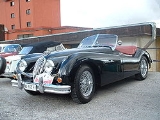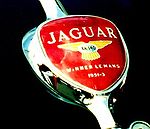
Jaguar XK140
Encyclopedia
The Jaguar XK140 is a sports car
manufactured by Jaguar between 1954 and 1957, the successor to Jaguar's highly successful XK120
. Upgrades included better brakes, rack and pinion
steering, increased suspension travel and modern tube type shock absorbers instead of the older lever arm design.
 Front grille size stayed the same but became a one piece cast unit with fewer, thicker vertical slats. The Jaguar badge was fitted to the grille itself, rather than being mounted between the grille and hood/bonnet as on the XK-120. A chrome trim strip extended back over the bonnet and at the rear continued down the centre of the boot (trunk) lid, where it contained a red shield with the words "Winner Le Mans
Front grille size stayed the same but became a one piece cast unit with fewer, thicker vertical slats. The Jaguar badge was fitted to the grille itself, rather than being mounted between the grille and hood/bonnet as on the XK-120. A chrome trim strip extended back over the bonnet and at the rear continued down the centre of the boot (trunk) lid, where it contained a red shield with the words "Winner Le Mans
1951–3" inscribed in gold.
The interior was improved for taller drivers with an addition of 3 inches (76 mm) of legroom, as a result of relocating the engine, firewall and dash forward. The new arrangement left no room for the XK120 battery compartment, and the single battery was now located low down inside the wing on the inlet side, making it almost impossible to replace.
The XK140 continued to feature the famous Jaguar XK engine
with the Special Equipment modifications from the XK120 as standard, increasing the specified power by 10 bhp to 190 bhp gross at 5500 rpm. The special C-Type cylinder head was also carried through from the XK120 catalogue as an option, specified at 210 bhp gross at 5750 rpm.
A car fitted with the C-type cylinder head, 2-inch sandcast H8 carburettors, heavier front torsion bars and twin exhaust pipes was known in the UK as an XK-140 SE. In North America it was popularly called an XK-140 MC.
In 1956 the XK140 became the first Jaguar sports car to be offered with an automatic transmission. As with the XK120, wire wheels and dual exhausts were options, although most cars imported into the United States had wire wheels. Cars with disc wheels continued to be offered with fender skirts
(spats) closing the rear wheel arch.
The XK140 was available in three body styles. The OTS (Open Two Seater) roadster had a light canvas top assembly that when lowered fitted behind the seats and thus completely disappeared inside the body. The interior of the OTS was trimmed in leather and leatherette, including the dash. Like the XK120 Roadster, the XK140 OTS had removable canvas and plastic side curtains on light alloy doors, and either a long or short tonneau cover to keep the cockpit dry with the top down.
As well as real wind-up windows, the DHC (Drop Head Coupe) had a permanently mounted padded soft top that when lowered sat above and outside the body of the car. it also had a fixed windscreen (unlike the removable windscreen of the OTS). The DHC had a very elegant walnut-veneered dash and door cappings, as did the FHC (Fixed Head Coupe). As a gesture to practicality, a jump seat
was added to both coupe
models. The FHC's windscreen was mounted further forward, giving it considerably more interior space than the DHC.
Acceleration times from 0–60 mi/h were 8.4 seconds, 9.1 seconds and 9.1 seconds respectively. Only the R&T test tried 0–100 mi/h which took 26.5 seconds. Standing 1/4 mile (~400 m) times were 16.6 seconds (82 mi/h approx) and 16.9 seconds (86 mi/h).
Sports car
A sports car is a small, usually two seat, two door automobile designed for high speed driving and maneuverability....
manufactured by Jaguar between 1954 and 1957, the successor to Jaguar's highly successful XK120
Jaguar XK120
The Jaguar XK120 is a sports car which was manufactured by Jaguar between 1948 and 1954. It was Jaguar's first sports car since the SS 100, which ceased production in 1940.-History:...
. Upgrades included better brakes, rack and pinion
Rack and pinion
A rack and pinion is a type of linear actuator that comprises a pair of gears which convert rotational motion into linear motion. A circular gear called "the pinion" engages teeth on a linear "gear" bar called "the rack"; rotational motion applied to the pinion causes the rack to move, thereby...
steering, increased suspension travel and modern tube type shock absorbers instead of the older lever arm design.
History
The XK140 was introduced in late 1954 and sold as a 1955 model. The primary visual change was the more substantial front and rear bumpers, with large overriders. Another new feature was modern flashing turn signals, operated by a separate switch on the dash. The twin amber lights positioned above the front bumper helped to distinguish the XK140 – until XK120 owners started installing the same equipment.
24 Hours of Le Mans
The 24 Hours of Le Mans is the world's oldest sports car race in endurance racing, held annually since near the town of Le Mans, France. Commonly known as the Grand Prix of Endurance and Efficiency, race teams have to balance speed against the cars' ability to run for 24 hours without sustaining...
1951–3" inscribed in gold.
The interior was improved for taller drivers with an addition of 3 inches (76 mm) of legroom, as a result of relocating the engine, firewall and dash forward. The new arrangement left no room for the XK120 battery compartment, and the single battery was now located low down inside the wing on the inlet side, making it almost impossible to replace.
The XK140 continued to feature the famous Jaguar XK engine
Jaguar XK6 engine
The renowned Jaguar XK dual overhead camshaft inline 6-cylinder engine was introduced in 1949 and continued in manufacture until 1992. It was produced in five displacements for Jaguar passenger cars, with other sizes being made by Jaguar and privateers for racing...
with the Special Equipment modifications from the XK120 as standard, increasing the specified power by 10 bhp to 190 bhp gross at 5500 rpm. The special C-Type cylinder head was also carried through from the XK120 catalogue as an option, specified at 210 bhp gross at 5750 rpm.
A car fitted with the C-type cylinder head, 2-inch sandcast H8 carburettors, heavier front torsion bars and twin exhaust pipes was known in the UK as an XK-140 SE. In North America it was popularly called an XK-140 MC.
In 1956 the XK140 became the first Jaguar sports car to be offered with an automatic transmission. As with the XK120, wire wheels and dual exhausts were options, although most cars imported into the United States had wire wheels. Cars with disc wheels continued to be offered with fender skirts
Fender skirts
Fender skirts, known in Australia and the United Kingdom as spats, are pieces of bodywork on the fender that cover the upper portions of the rear tires of an automobile.-Functions:...
(spats) closing the rear wheel arch.
The XK140 was available in three body styles. The OTS (Open Two Seater) roadster had a light canvas top assembly that when lowered fitted behind the seats and thus completely disappeared inside the body. The interior of the OTS was trimmed in leather and leatherette, including the dash. Like the XK120 Roadster, the XK140 OTS had removable canvas and plastic side curtains on light alloy doors, and either a long or short tonneau cover to keep the cockpit dry with the top down.
As well as real wind-up windows, the DHC (Drop Head Coupe) had a permanently mounted padded soft top that when lowered sat above and outside the body of the car. it also had a fixed windscreen (unlike the removable windscreen of the OTS). The DHC had a very elegant walnut-veneered dash and door cappings, as did the FHC (Fixed Head Coupe). As a gesture to practicality, a jump seat
Jump seat
A jump seat , in aviation refers to an auxiliary seat for individuals — other than normal passengers — who are not operating the aircraft. In general, the term 'jump seat' can also refer to a seat — in any type of vehicle — which can fold up out of the way; vehicles include carriages, automobiles,...
was added to both coupe
Coupé
A coupé or coupe is a closed car body style , the precise definition of which varies from manufacturer to manufacturer, and over time...
models. The FHC's windscreen was mounted further forward, giving it considerably more interior space than the DHC.
Engine specifications
| Model | Years | Displacement | Configuration | Bore/Stroke | Carburettor | Power |
|---|---|---|---|---|---|---|
| XK 140 3.4 | 1954-1957 | |
DOHC Straight-6 | |
Double SU H6 | 190 bhp @ 5500 rpm |
| XK 140 3.4 SE (C-Type Head)("MC" in USA) | 1954-1957 | |
DOHC Straight-6 | |
Double SU H8 | 210 bhp @ 5750 rpm |
Performance
Realistically, a stock XK-140 SE could achieve a top speed of 120–125 mph (193-201 km/h). Road & Tracks XK-140 MC test in June 1955 recorded a best two-way average of 120.3 mi/h. Best one-way run was 121.1 mi/h. Sports Cars Illustrateds test of the same model in Aug 1957 had a fastest two-way average of 121 mi/h. Their best one-way run was 124 mi/h. Karl Ludvigsen's test published in Sports Car World (July 1957) had the same results as the SCI test.Acceleration times from 0–60 mi/h were 8.4 seconds, 9.1 seconds and 9.1 seconds respectively. Only the R&T test tried 0–100 mi/h which took 26.5 seconds. Standing 1/4 mile (~400 m) times were 16.6 seconds (82 mi/h approx) and 16.9 seconds (86 mi/h).
External links
- XKData.com volunteer maintained online registry with thousands of cars

